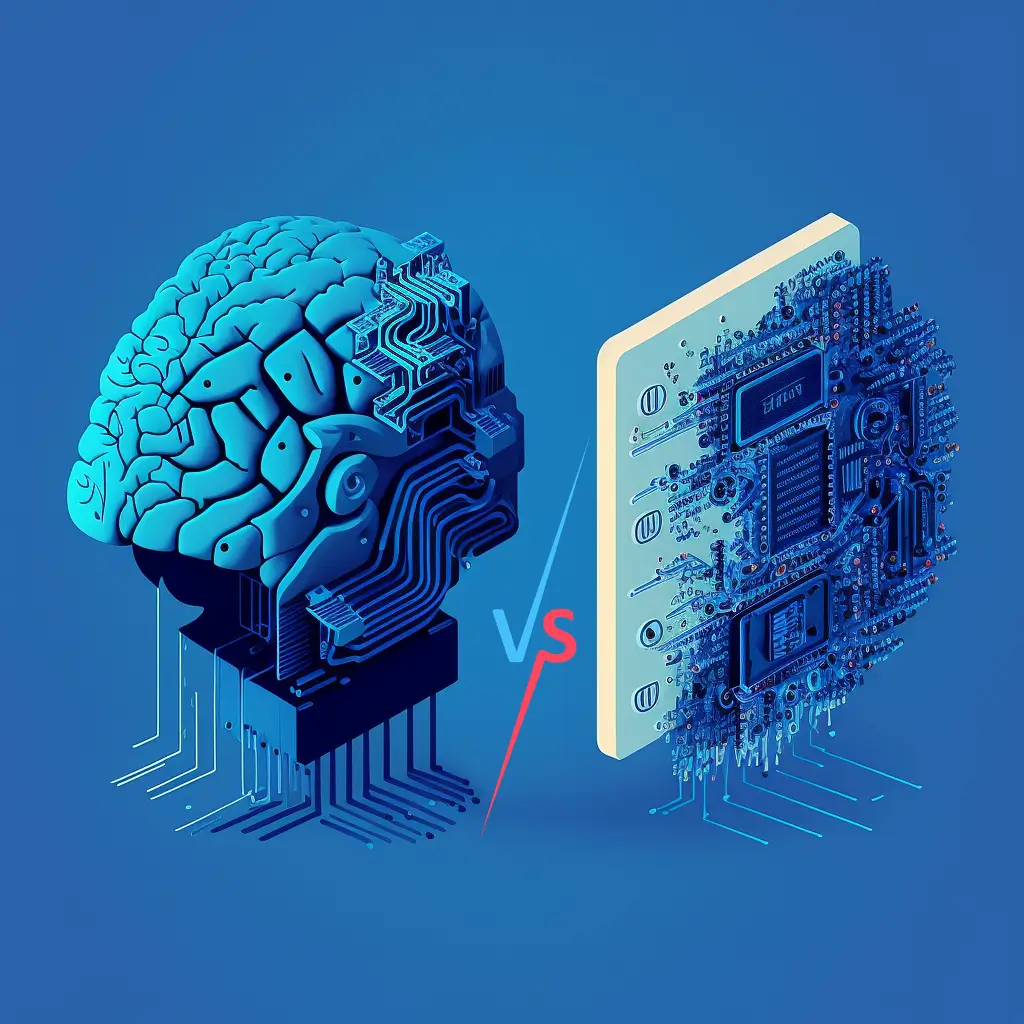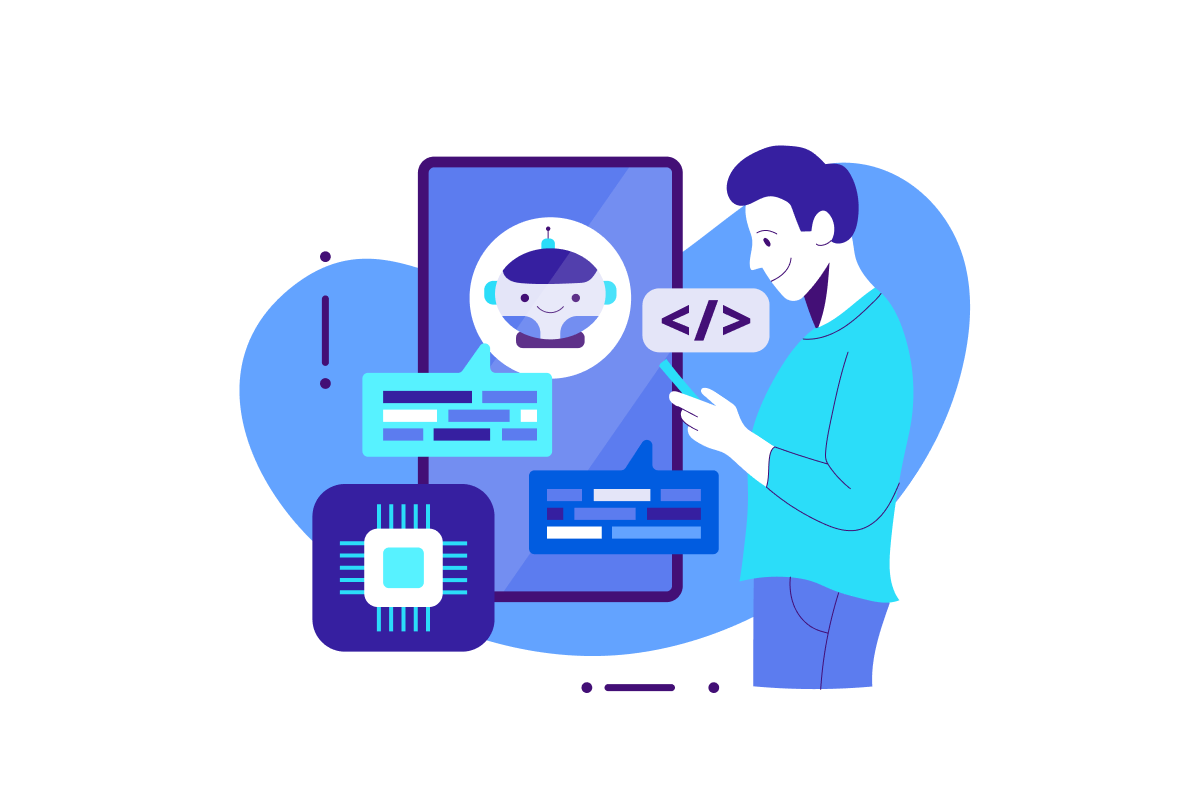Machine learning (ML) algorithms are now a part of our everyday lives, not just something from science fiction. They drive new ideas across industries and change how we use technology. ML algorithms lead the AI revolution, from Netflix recommendations tailored to you to medical diagnoses that save lives. A Statista report shows the global machine learning market will grow from $49.54 billion in 2020 to $503.40 billion by 2030, with a compound annual growth rate (CAGR) of 34.8%. This rapid growth shows how much we rely on ML to solve hard problems and find new chances.
Think about this: Spotify uses unsupervised learning algorithms to make playlists just for you, while Tesla uses reinforcement learning to train its self-driving cars. These real-life examples show how flexible and strong ML algorithms are. Yet many people find it hard to understand how these algorithms work even though they’re used a lot. This article makes machine learning algorithms easier to grasp. It looks at their types, uses, and how they can change industries.
Why Machine Learning Matters
Imagine a doctor treating diabetic retinopathy with a machine-learning app in rural India by examining a retinal scan—with 95% accuracy; a self-driving car drives through Mumbai chaos, avoiding pedestrians and potholes like an experienced driver would. A farmer in Kenya receives a text to his cell phone from an algorithm analyzing weather patterns and soil data on the best day to plant crops. These aren’t hypothetical scenarios. They’re real-world examples of machine learning in action, and they’re just the beginning.
Solving real-life challenges to save lives and create opportunities will remain the heart of machine learning. This is converting into usable insights the monstrous avalanche of data generated by mankind every day—2.5 quintillion bytes— to put it in perspective. Machine Learning empowers the machine to learn from experience, adjust to new inputs, and render judgments that were once the exclusive territory of the human.
To look at how it works in different sectors:
- Healthcare: Machine learning algorithms help doctors detect diseases, such as cancers, earlier and more accurately. Google’s DeepMind has, for instance, developed an AI system that can predict acute kidney injury up to 48 hours in advance—an effort that could save many lives.
- Retail: Amazon’s recommendation engine, based on machine learning, drives 35% of its total sales. It’s not just about recommendations; it’s about knowing what you want before you do.
- Finance: Fraud detection systems powered by ML analyze millions of transactions in real time. An example is PayPal, which relies on machine learning to prevent fraudulent transactions each year and save billions of dollars.
- Agriculture: Programs such as those by Blue River Technology applying machine learning render “smart farming” possible, wherein robots distinguish weeds and spray them with great precision, reducing herbicide use by about 90%.
But machine learning isn’t just about solving today’s problems. Its potential goes into areas that may seem distant today. For instance:
- Climate Change: Algorithms are using machine learning (ML) to analyze satellite data to monitor deforestation, predict wildfires, and optimize renewable energy grids. Google used ML to reduce data center power consumption by 40%, which is equivalent to taking millions of cars off the road.
- Education: ML personalizes education by adapting learning to each student’s pace and style through platforms like Khan Academy. It’s not just about making education more efficient; it’s about making it fairer.
- Space Exploration: NASA is now using machine learning to examine data from Mars rovers, helping scientists identify possible signatures of life and plan future missions.
Why does machine learning matter? ML is changing not only the world but also the lens through which we understand it. It allows us to discern patterns, predict outcomes, and decide with unimaginable precision. It is helping us develop a truly intelligent tomorrow.
What Are the Types of Machine Learning Algorithms?
Machine learning algorithms are categorized into distinct types, each serving specific purposes in extracting patterns and insights from data. These categories are crucial in understanding the diverse applications of machine learning. Here are the primary types:
- Supervised Machine Learning Algorithms
- Semi-Supervised Machine Learning Algorithms
- Unsupervised Machine Learning Algorithms
- Reinforcement Machine Learning Algorithms
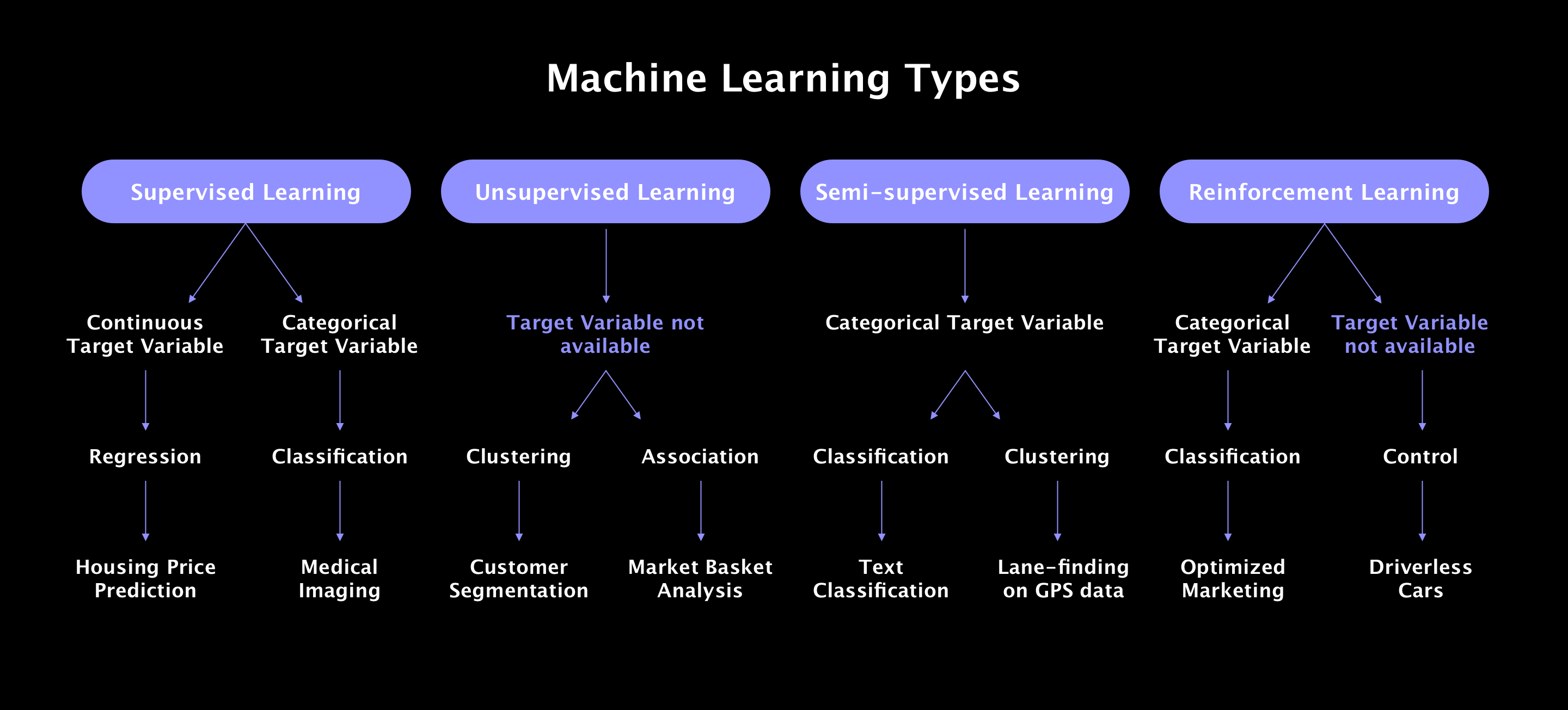
Comparison Table of Machine Learning Algorithms
| Algorithm Type | Purpose | Learning Approach | Common Use Cases | Advantages | Disadvantages |
| Supervised | Predict outcomes from labeled data | Learns from labeled input-output pairs | Spam detection, stock price prediction, fraud detection | High accuracy, easy to understand and deploy | Requires large labeled datasets, time-consuming labeling |
| Unsupervised | Find patterns in data without labels | Discovers hidden structures in unlabeled data | Customer segmentation, anomaly detection, recommendation systems | Effective with unstructured data, no labeling required | Results can be less interpretable, difficult to validate |
| Semi-Supervised | Mix of supervised and unsupervised learning | Partially labeled training data | Speech recognition, text classification, bioinformatics | Less labeled data needed, balances learning complexity | Potential for biased results from insufficient labels |
| Reinforcement | Optimize decision-making over time | Trial and error with feedback loop | Self-driving cars, robotics, game AI | Adapts to dynamic environments, learns autonomously | Computationally expensive, slow learning process |
What are Supervised Machine Learning Algorithms?
Supervised machine learning is the foundational approach in ML algorithms. It offers a level of control that allows programmers to steer the system toward desired outcomes.
In this paradigm, the engineer determines the data inputs and specifies the expected outputs. This is akin to giving the machine a set of instructions: process this data and produce solutions in a predefined manner.
To illustrate, consider a scenario where you wish to estimate the time it takes to reach a grocery store from your home. By inputting relevant data, such as the time of day, into the system, you can prompt the machine to deliver an outcome—the predicted travel time to the store.
Supervised machine learning involves two essential processes—classification and regression:
- Classification:
In the classification stage, the system decides the type of information it receives. It must categorize the input data into different classes or predefined categories. This could be as straightforward as determining whether an email is “spam” or “not spam” based on certain criteria established during the training phase.
- Regression:
During the regression process, the system identifies patterns within the data to predict continuous outputs. This capability allows data scientists to comprehend and forecast phenomena with constant variables, such as understanding sales or marketing seasonal patterns. It’s a valuable tool for extracting insights from data that exhibit trends and patterns over time.
In essence, supervised machine learning empowers programmers and data scientists to guide the system in making informed decisions based on labeled data. It provides a structured and controlled approach to problem-solving in diverse domains.
Case in Point
- Logit Regression:
Also known as logistic regression, logit regression is designed to predict a discrete value based on given input or independent variables. This ML algorithm predicts a binary outcome, such as true or false, by calculating the probability of the event occurring. It is commonly used when the dependent variable represents categorical data with two possible outcomes.
- Random Forest:
Random Forest is a versatile machine-learning algorithm used for data classification and regression. Its underlying principle is the collective strength of multiple decision trees forming a “forest.” As more data is fed into the ML algorithm, the predictions become more accurate and robust. Thus, it is a powerful tool for handling complex datasets and ensuring robust predictions.
- Neural Networks:
Neural Networks, a cornerstone of deep learning, find applications across various machine learning techniques. Inspired by biological neural networks, these systems are versatile approximators of functions, mapping inputs to outputs.
Neural networks excel at recognizing complex patterns and are employed for tasks such as image recognition, natural language processing, and predictive modeling. Their architecture is inspired by the interconnected structure of human neurons, allowing them to adapt and learn from data patterns in a way reminiscent of human cognition.
How It Looks at Work
The utilization of machine learning algorithms as a service has become ubiquitous, particularly in forecasting future prices within industries such as sales, commerce, and stock markets.
These sectors heavily rely on accurate predictions to inform decision-making. Leveraging supervised ML algorithms enhances the precision of these forecasts, offering a valuable tool for improved insights.
Prominent sales platforms, including Highspot and Seismic, strategically employ supervised machine learning algorithms to refine their predictive capabilities. This streamlines pricing strategies and empowers businesses with a competitive edge by making informed decisions based on reliable forecasts.
What are Unsupervised Machine Learning Algorithms?
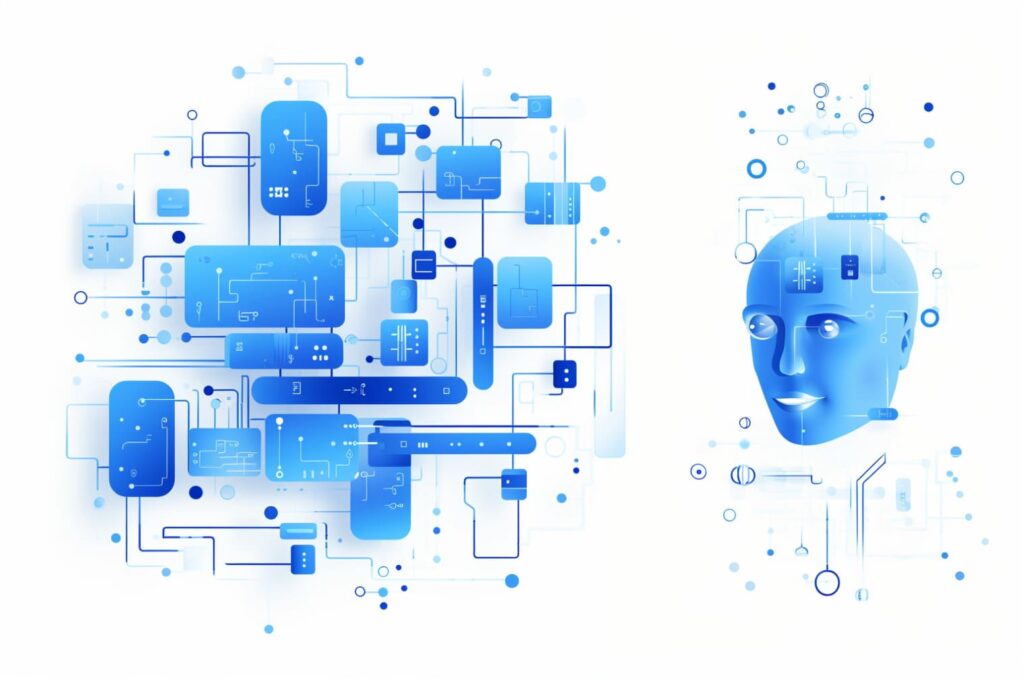
In supervised machine learning, the machine is tasked with producing a predetermined outcome, whereas in unsupervised learning, the outcome is undefined, and the machine must autonomously define and provide it.
In this mode, the machine discerns the underlying data structure, extracting valuable insights and identifying patterns. These insights contribute to enhanced efficiency in future tasks.
The initial phase involves clustering, where data is grouped into distinct segments—subsequently, the machine endeavors to distill useful information from the collective data by reducing its dimensionality.
Case in Point
- K-means Clustering
Among the simplest unsupervised machine learning algorithms, K-means clustering involves defining clusters based on K centers. The method strategically positions these centers to maximize the distance between each, assigning data points to the group represented by the nearest K-center. Widely used in various applications, K-means clustering efficiently categorizes data, facilitating pattern recognition and analysis.
- Principal Component Analysis (PCA)
PCA is a transformative procedure that classifies data into unrelated components known as principal components. This is achieved through an orthogonal transformation, a linear transformation of a vector space that preserves vector lengths. PCA is instrumental in simplifying complex datasets, revealing key patterns, and reducing dimensionality without sacrificing critical information.
- t-Distributed Stochastic Neighbour Embedding
Commonly applied to visualization challenges, t-SNE addresses high-dimensional problems by reducing the dimensions of intricate data to more manageable 2D or 3D representations. This technique proves invaluable in rendering complex visualizations comprehensible, aiding in exploring and understanding intricate relationships within datasets.
- Association Rule
Association rule mining, an extensively employed method in unsupervised learning, aims to uncover relationships between components within vast databases. This rule-based method is particularly adept at revealing intriguing connections, such as associations between purchased products and the utilization of point-of-sale (PoS) machines in supermarket sales data. By extracting meaningful associations, this technique contributes to enhanced decision-making and strategic planning.
How It Looks at Work
Unsupervised ML algorithms are crucial in digital marketing and advertising, particularly customer segmentation and targeting.
Instead of a general statement about “customer-centric information,” let’s break it down into concrete examples:
Salesforce’s Einstein Analytics: This platform applies unsupervised ML algorithms to analyse customer purchase history, website browsing behavior, and social media interactions. They can then automatically cluster customers into distinct segments based on shared characteristics, preferences, and purchase likelihood. This segmentation allows marketers to tailor email campaigns, product recommendations, and targeted advertising strategies, leading to more personalized and effective customer experiences.
Netflix: Unsupervised ML algorithms power Netflix’s recommendation engine. By analyzing viewing history, search trends, and ratings across its vast user base, the platform identifies hidden patterns and relationships within the data. This allows Netflix to recommend movies and series that each user is most likely to enjoy, increasing engagement and user retention.
Spotify: Similar to Netflix, Spotify utilizes unsupervised learning to create personalized playlists and discover new music for its users. By analyzing listening habits, genre preferences, and social networks, the platform can recommend artists and songs that align with each user’s individual taste. This fosters user engagement and strengthens the connection between Spotify and its audience.
Semi-supervised Machine Learning Approaches

Semi-supervised learning is a combination of supervised and unsupervised learning. It’s used when there is not much data to train the system, so it is only partially trained. The information the computer learns during this partial training is called pseudo-data. Later, the computer uses both labeled data and pseudo-data to make predictions.
Case in Point
- uClassify: Organizing Information with Ease
Customer Support Triage at Zendesk: uClassify streamlines customer support at Zendesk by automatically classifying incoming emails into categories like billing inquiries, technical support requests, or feature suggestions. This efficient routing ensures faster responses and better customer experiences.
Multilingual News Monitoring at Global Media Agencies: News organizations use uClassify to organize and analyze news articles in multiple languages. The tool identifies topics, sentiments, and key entities, enabling journalists to track emerging trends, gauge public opinion, and deliver relevant content to diverse audiences.
Social Media Insights for Brands: Marketers leverage uClassify to classify social media posts, tweets, and reviews, gaining insights into customer sentiment, product feedback, and brand perception. This helps them tailor campaigns, address concerns, and build stronger relationships with their customers.
- GATE: Unlocking Knowledge from Text
Biomedical Research at Stanford University: GATE powers Stanford’s literature mining projects, which extract information from vast collections of scientific articles to identify potential drug targets, uncover new gene interactions, and accelerate research progress.
Digital Humanities Projects at Oxford University: Oxford researchers use GATE to analyze historical texts, conduct sentiment analysis on historical figures, and explore the evolution of language and culture over time. This sheds new light on social and cultural patterns in history.
How It Looks at Work
While supervised learning requires large amounts of labeled data, semi-supervised ML algorithms can achieve impressive results by blending labeled and unlabeled data.
- Healthcare Diagnosis and Prognosis:
Early Detection of Diseases: Analyzing medical images with limited labeled data is a challenge. Semi-supervised machine learning algorithms can learn from small sets of labeled annotations and identify subtle patterns in unlabeled scans, potentially aiding in the early detection of cancers or other diseases. Check out more use cases at the link.
For instance, researchers at Stanford University used this approach to analyze chest X-rays, achieving promising results in detecting pneumonia even with limited annotated data.
Drug Discovery and Development:
- Speech Recognition and Natural Language Processing:
Improving Speech Recognition Accuracy: Training accurate speech recognition models often requires vast amounts of labeled audio data, which can be expensive and time-consuming to collect.
Semi-supervised techniques can leverage unlabeled audio streams (like podcasts or movie dialogues) to improve the accuracy of speech recognition models. This makes them more robust and adaptable to diverse accents and background noise. Google Voice Search utilizes this approach to continuously improve its ability to understand spoken queries.
- Regulatory Compliance and Fraud Detection:
Identifying Financial Fraud: Financial institutions face the constant challenge of detecting fraudulent transactions and activities. Semi-supervised ML algorithms can analyze transaction data to identify anomalies and patterns indicative of fraud, even in cases where only a small proportion of transactions are labeled as fraudulent. This proactive approach helps prevent financial losses and protect customers.
Reinforcement Learning for Dynamic Environments
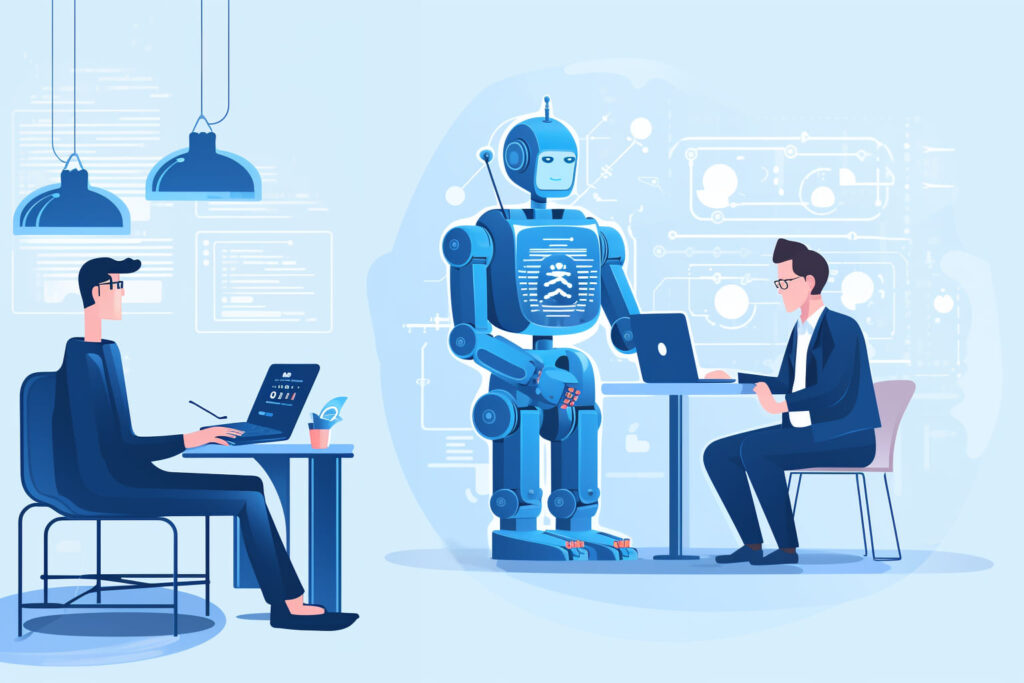
Reinforcement in machine learning is like teaching a computer to get better at tasks over time. The computer learns and improves by using labeled data and new information. It’s a self-sustaining process, and the computer becomes more advanced with each task it completes.
It follows a loop of trying different things (exploration) and using what works (exploitation). After each task, the computer examines the results, learns from them, and improves for the next job. The feedback it receives can be good or bad, and the computer adjusts itself using the feedback to do better in the future and avoid things that didn’t work well.
Case in Point
- Q-Learning: Mastering Games and Navigating Challenges
AlphaGo’s Victory: In 2016, DeepMind’s AlphaGo stunned the world by defeating a world champion in the complex game of Go. Q-learning was a key component of its reinforcement learning framework, enabling it to learn optimal strategies through self-play and master a game once considered too intricate for AI.
Resource Management and Optimization: Q-Learning helps optimize resource allocation in various systems, such as energy grids or communication networks.
- Monte Carlo Tree Search: Conquering Games and Solving Complex Problems With ML Algorithm
Game AI Supremacy: MCTS excels in games with high branching factors and limited information, like Go, Chess, and Poker. It’s the driving force behind AI agents that have surpassed human performance in these domains, demonstrating its ability to handle complex decision-making under uncertainty.
How It Looks at Work
1. Gaming: Adapting to the Unpredictable
Grand Theft Auto’s Dynamic World: The acclaimed GTA series utilizes reinforcement learning to create dynamic in-game characters who adjust their behavior based on player interactions. These NPCs learn to drive, fight, and interact with the environment in increasingly sophisticated ways, enhancing the immersive and unpredictable nature of the gameplay.
2. Beyond Games: Navigating Real-World Dilemmas
Self-Driving Cars: From Pixels to Perception: Reinforcement learning plays a crucial role in self-driving cars. These machine-learning algorithms process visual data from cameras and sensors, learn to identify roads and obstacles, and make real-time decisions about navigating traffic and complex scenarios. Companies like Tesla and Waymo are actively refining this technology to bring safer and more autonomous driving experiences to the streets
Robotics: Learning to Walk and Manipulate: From dexterous robots performing intricate surgery to agile machines exploring Mars, reinforcement learning is shaping the future of robotics. These ML algorithms help robots learn motor skills, adapt to changing environments, and even collaborate with humans, pushing the boundaries of what’s possible in intelligent automation.
3. Natural Language Processing: Understanding the Nuances of Speech
Personalized Chatbots and Assistants: Reinforcement learning allows virtual assistants like Google Assistant and Amazon Alexa to learn from user interactions and improve their responses over time. By understanding subtle cues and adapting their dialogue based on user feedback, these artificial intelligence algorithms become more natural and engaging in their interactions. Discover the difference between artificial intelligence and machine learning in our article.
Machine Translation: Bridging the Language Gap: Advancements in machine translation are fueled by reinforcement learning algorithms. These systems are trained on large amounts of translated text, constantly learning and refining their translation models to produce more accurate and nuanced renditions across languages.
The Future of Machine Learning Algorithms
From the creation of artworks almost on the verge of imitation to private and decentralized learning, machine learning promises a sea change for industries and ideologies.
Generative AI: The Machines as Creators
Generative AI, using a generative algorithm such as ChatGPT and DALL-E, is a creative revolution. These models use voluminous training data to generate human-like text, images, and even music.
- ChatGPT is trained on large-scale datasets in human language, making it useful for automating customer interactions, generating content, and supporting research and other business tasks.
- DALL-E: DALL-E is an image-generation AI that takes text prompts and turns them into pretty much any image you want. It offers the ability to help industries like marketing, entertainment, and design to create creative content democratization. Do you want to know how to build an image-generating tool like DALL-E? Read our blog.
These are tools for further automation. Even more so, the production processes are being reframed to enable non-experts to generate top-notch content without breaking a sweat.
Federated Learning: Privacy-Preserving AI
Federated learning is a way to train machine-learning models on data across decentralized devices without sharing user data because of concerns over data privacy.
- How It Works: The data will remain on user devices (smartphones, tablets) while the model learns patterns by locally aggregating insights.
- Real-World Example: The Gboard keyboard from Google applies federated learning to enhance text predictions without undermining privacy.
An approach that protects privacy is vital in sectors such as healthcare and finance, where the confidentiality of sensitive data is paramount.
Quantum Machine Learning: Unlocking Unimaginable Power
Traditional computing has limitations when handling massive datasets and complex problems. Quantum machine learning (QML), powered by quantum computers, will transform this field by exponentially speeding up computational tasks.
- How It Works: Quantum computers use qubits (quantum bits) to accomplish many calculations at once, thus enhancing the speed and efficiency of the machine-learning procedure.
- Potential Applications: Financial modeling, drug discovery, climate prediction, and secure cryptographic systems.
The future of ML algorithms will involve more than data processing. They will also promote creativity, privacy, and the resolution of problems previously thought unsolvable. With the rise of generative AIs, federated learning, and quantum technologies, we are right at the edge of an AI era, ushering in unprecedented changes.
Wrapping Up
With a significant impact across industries, these ML algorithms automate processes and provide foresight for informed decision-making.
Despite their prevalence, the intricacies of these algorithms remain enigmatic to many. As these algorithms advance, they herald a future where artificial intelligence seamlessly integrates into daily life, enhancing efficiency and decision-making.

